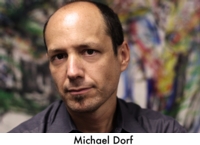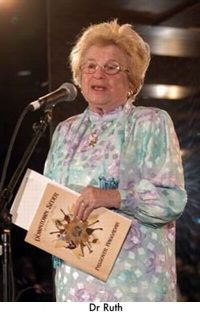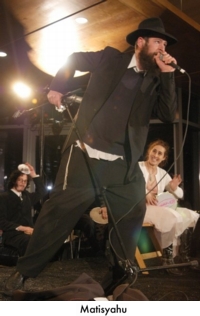 More than fashion, more than film, even more than television, music drives culture in America. And as America goes, so go the Jews. But despite a consistent stream of Jewish voices in literature, film, art, and other creative forms, dynamic Jewish musical culture was dead twenty years ago. A little bit of klezmer at wedding parties kept the notion of Jewish music alive, but since the heyday of Jewish jazz musicians in the 40s and 50s, a serious American Jewish musical culture did not emerge until a strange confluence of events at 47 E. Houston Street between Mott and Mulberry in New York City.
More than fashion, more than film, even more than television, music drives culture in America. And as America goes, so go the Jews. But despite a consistent stream of Jewish voices in literature, film, art, and other creative forms, dynamic Jewish musical culture was dead twenty years ago. A little bit of klezmer at wedding parties kept the notion of Jewish music alive, but since the heyday of Jewish jazz musicians in the 40s and 50s, a serious American Jewish musical culture did not emerge until a strange confluence of events at 47 E. Houston Street between Mott and Mulberry in New York City.
Michael Dorf, then manager for the band Swamp Thing, was hoping to find a home for his interests in music, a kind of coffeehouse where people could groove to cool records and chill. He found a space – 2,000 square feet in such lousy condition it was nicknamed “The Dump” – and before he knew it, a cluster of avant-garde jazz musicians had descended on the newly minted Knitting Factory, beginning to call it home. John Zorn became a fixture at the Knit along with a new generation of radical klezmer musicians still working today, including the legendary Klezmatics.
The seeds of “New Jewish Culture” were planted at the Knitting Factory. While Shlomo Carlebach worked the rooms of traditional liturgy and music with three chords and hippy love, Dorf was calling out to Jews to return to Jewish identities by way of the edgy downtown music scene of New York City. The Jewish movement of spiritual, creative, and even academic innovation seeping through American culture today is a direct result of music’s ability to shake up and wake up Jewish expression in dialogue with both tradition and the best of popular culture. Without the sound and vision and fun that radiated outward from the Knitting Factory, Jewish culture might still taste as bland as those hard candies in ceramic dishes in your Bubba’s living room. As the downtown Jewish music scene grew, the face of ritual and textual tradition was peaking its head over the table like the youngest child at the Passover seder, asking about the religious significance of the cultural work of Dorf and others. Carlebach placed himself and his disciples squarely in the synagogue, but could “New Jewish Culture” sustain itself by rituals of music and art alone?
In the spirit of these questions, Dorf launched the idea of doing Passover like it has been done again and again for thousands of years – by telling the story anew, question after question. In 1996, two-hundred people gathered at the Knitting Factory to eat, schmooze, and talk Passover with music, poetry, performance, and yes, some readings from the Haggadah. This year marked the seventh Downtown Seder.
Zeek spoke with Michael Dorf, one of Jewish culture’s most compelling impresarios.
Peter Bebergal: When were the seeds for the Downtown Seder first planted?
Michael Dorf: I need to give my dad some credit. In Wisconsin, growing up, he really did his best to make our Passover seders relevant, and would include Martin Luther King readings, some poetry, and a lot of political conversation, tying as much as possible of the classic story to the issues around the world. I remember a lot of seders having big arguments in the family about Reagan’s involvement in Central America. Half of the table was in support of the Sandinistas and connected them to the Jews leaving Egypt. And my great uncles would be freaking out saying ‘You have no respect for the government!’
During the mid-part of the 90s at the Knitting Factory the development of new Jewish music was already being identified as something that we were very involved in. I’d already done a few tours of Europe under the Jewish Alternative Movement label. [John] Zorn might have already have launched Tzadik. And Masada had been formed.
PB: Was Jewish music part of the original vision for the Knitting Factory?
MD: Well, my original vision was extremely wide open. I started it with Bar Mitzvah savings. It was $25,000. My parents were pissed, because I’d saved this money for college. And then my dad kind of conned me into paying for some of it and taking out student loans. So I had this little tiny nest egg, and I came up with this idea for starting a performance space/café as a way to stay in New York and be in the music business. I actually wanted to have a record label. But I was failing at that side of the business, so I needed to live and have some sort of cash flow so I thought a café was the way to go – in that Jack Kerouac-inspired kind of free-for-all. I wanted jazz. I wanted avant-garde sounds. I wanted stuff that was really new.
So whether it was Don Byron coming in and introducing me to the music of Mickey Katz or what Frank London was doing, there was this kind of convergence, if you will, as part of the music scene. It was certainly not a clarified sector, but it was an aspect of what was being done that I found intriguing. I wasn’t an alienated Jew, but I didn’t feel the connection. And all of a sudden, there was something innate in this collective unconscious of Judaism that connected me to it.
 That, combined with being in the Lower East Side on Houston Street – walking over to Katz’s, Yonah Schimmel’s – I felt this personal little thing, and then I realized that there were a lot of musicians living in the East Village and the Lower East Side that were also in this exploration of their identity. They weren’t attending any Hillel thing, but they were saying, ‘Gosh, it’s funny, all the people who play at the Knitting Factory are either black or Jewish. What is it about the fact that we have this in our backgrounds, and we’re all curious about it, and we’re all the most experimental jazz artists that are out there? There must be a connection.’ It wasn’t part of a business plan, and it also wasn’t a very conscious move. It was really just this kind of startling, organic thing.
That, combined with being in the Lower East Side on Houston Street – walking over to Katz’s, Yonah Schimmel’s – I felt this personal little thing, and then I realized that there were a lot of musicians living in the East Village and the Lower East Side that were also in this exploration of their identity. They weren’t attending any Hillel thing, but they were saying, ‘Gosh, it’s funny, all the people who play at the Knitting Factory are either black or Jewish. What is it about the fact that we have this in our backgrounds, and we’re all curious about it, and we’re all the most experimental jazz artists that are out there? There must be a connection.’ It wasn’t part of a business plan, and it also wasn’t a very conscious move. It was really just this kind of startling, organic thing.
I had already started a klezmer festival during Hanukkah at the Knitting Factory, but then I converted it to a Radical Jewish Culture festival. And John helped curate that for a couple years. Then that turned into the whole Jewish alternative music scene. I started getting involved in this kind of Yiddish and Jewish radical culture, but it was still very much under the radar. The 92nd Street Y didn’t really put on much music except for some traditional klezmer stuff. It’s hard to even remember a time when there wasn’t as much Jewish music all over the place. Sixteen, seventeen years ago, there really wasn’t a lot of that.
I can’t remember where the exact conversation was, but it was like, ‘I want to throw a seder, because all these musicians need a place to gather on Passover.’ And I thought, let’s make this a homey seder. But then I had two puzzling epiphanies. The first was how the hell am I going to pay for the catering for sixty musicians?
PB: Were you going to have it be kosher?
MD: Well, I didn’t care so much about kosher. We were doing it as ‘kosher style.’ I hired a caterer friend at the time. And being the cheap commercial Jew I am, I think I got Empire Chickens.
PB: That’s good chicken, though.
MD: It’s good chicken. So we did kosher style. It came out to about $30 a head. So I thought, sixty musicians times $30 is $1,800. I needed to figure out a way to pay the $1,800. I don’t need to make any money this night, but I can’t lose money. I didn’t have $1,800 to lose. I thought if I sold forty or fifty tickets to the public for $50, maybe there’s a way for me to at least recapture what I’m spending. But of course, in my infinite business acumen, I still didn’t figure in all the costs. And so the first year I think I ended up still losing about $1,000. But we sold the tickets very quickly. And it was an incredibly warm, really cool evening.
The other epiphany, though, had to do with the Haggadah. The beginning of the Haggadah says, ‘You need to retell the story of leaving Mitzrayim in a language that you understand.’ At first our forefathers read it in Hebrew, and then it went to Aramaic, and then from Aramaic, people would translate it to Yiddish or German. The mitzvah is to understand that you feel like you yourself were taken from bondage. I thought why not do it as the language of the arts, of music, of creative thinkers, and let people perform, and have that be their telling of the story?
PB: Who were some of the original performers at the first one?
MD: There was Philip Glass, Gary Lucas, Roy Nathanson, Frank London, Joey Baron, Ira Kaplan from the band Yo La Tengo. It was a hugely diverse group of people.
The second year, Lou Reed came. That blew me away. And when he came the next year he brought nine relatives from Brooklyn, his aunts and uncles. One, who knew Lou was Jewish? Two, who knew he had all this meishpocheh? And that really set the course. It became a way for people to get together in a really warm, fun way, and to share this communal experience in a format that they feel comfortable in, that they maybe wouldn’t otherwise.
PB: Much of art draws from religious tradition. So what does it mean to return back to the tradition and re-imagine it? Why is this a valuable thing to do?
MD: I think it’s a very fair and important question. As much as sometimes I fight a lot of the tradition, there’s some incredible value and insight and wisdom that comes with thousands of years or hundreds of years or even decades of people having done things in a certain way. But it’s clearly important to be re-imagining and reinterpreting them with a more intelligent, if you will, or more currently recognized modus operandi. The story of leaving Egypt, and the retelling of the story in an environment that is encouraging questions – which to me is almost the most salient element of the seder – to reinforce the questioning of how things are done and why, and do it around a story of true liberation, is incredible.
To figure out a way to keep that relevant, and reinterpret it, is an important job. It’s an important job as a leader in one’s own family, I believe. And as a producer, I can’t help but look at something like that and think, ‘I’ve got to do this for more people.’ I can’t help that instinct. A lot of times it gets me in trouble. But in this particular case, it was a way to merge my own personal travel, and my own intellectual thinking, combined with what seemed to be a real need of the community that I’m around, and use what I do, combined with the reexamination of this in a creative way.
 PB: There are some Christian churches that probably do a little of this. But there’s something particular about Judaism that makes it ripe for this kind of experiment or experience.
PB: There are some Christian churches that probably do a little of this. But there’s something particular about Judaism that makes it ripe for this kind of experiment or experience.
MD: The heart of the Seder in particular is this very clearly mandate to question the status quo.
PB: Which for some is the heart of Judaism.
MD: And that’s the heart of Judaism. How many interpretations of the Torah are there? You’ve got Rashi and then this level and this level. You can’t read a story without twenty opinions. How many Jewish opinions are there in a room with four Jews? Ten. We are an extremely opinionated group of people. But more important than the opinion is the ability to analyze something from a lot of different perspectives. And that’s to the heart of Judaism. Asking questions is challenging the brain to be learning. As an intellect, I can read a sentence in the Torah, and I only can usually come up with one or two ways to interpret it. Or I can read a novel and get it on its base level, and maybe occasionally a crib note helps me think about it another way. And then a teacher or professor will give you two or three more insights, but usually those need to be fed to me by the really learned person. In art, you can look at a painting or hear a song, or a piece or poetry, and that spurs – at least for me – so many more interpretive angles. In that sense I think that this approach to the Seder offers a whole bunch of other angles to be examining the story on some emotional and other kind of cerebral ways, not purely just the intellectual.
PB: Do you think there’s a danger that the original meaning somehow gets so watered down, so buried under all of contemporary – some would say secular – re-imagining that there’s nothing left anymore?
MD: There is truth to that. And that’s probably something to be reminded of, and to know that it’s important sometimes to circle back and taste some of the original on occasion. However, to not be willing to look at the contemporary for fear that it could get adapted and become the new original, is a fear that I certainly don’t want to perpetuate. I think you need to be able to reinterpret freely, and to try and remember where the past affected that work. There was an issue I had with the parameters that were being put on jazz for a while, and a battle I used to have with the jazz world. If it wasn’t classic jazz, it wasn’t jazz. Well, you know what? Classic jazz is amazing, and I love listening to classic jazz. But you need to allow people to move on and bring in a turntable.
PB: I could see the same really happening within the klezmer community. There are some real traditionalists that I would imagine thinking something Hasidic New Wave is just completely over-the-top.
MD: Exactly. But at the same time, when Frank London or Greg Wall are reworking and re-imagining their work, they pay absolute reverence, and hold with the highest respect where it came from in that original work. No one can recreate something perfectly, but where if someone is trying to just mimic and recreate the original, that’s great. And it’s nice to connect to that.
PB: Any celebrity buzz around the seder this year?
MD: This year, I got Neil Sedaka for the first time. People are freaked out. There are people who are coming to this thing – I don’t want to say it’s the wrong reason – but they bought a pair of tickets for $300 because they’re Neil Sedaka fans and they want to see Neil do five minutes of something in a seder.







